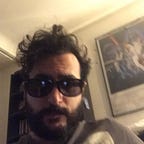30 in 30: A MONTH OF HORROR. SUSPIRIA (1977)
DAY 24
SUSPIRIA (1977)
Can murder be beautiful? Of course.
This is one visually arresting film if I’ve ever seen one. Only Argento can make a horror film scary and sublime; frames from this film should be hanging in museums all around the world.
The way shadows, lighting and colours play off each other in this descent to madness is truly hypnotic and terribly original. You’ve never seen such a bold choice in the color palette of a film’s lighting before. Primary colours tint the movie and turn it into a living nightmare. Welcome to surreal horror.
For the uninitiated, SUSPIRIA is a movie about an American dancer who moves to Germany to study in a very prestigious ballet academy. One by one her classmates start to suffer horrible deaths, only to learn that a witch coven is running the academy. Spooky!
It’s true, this movie is visually captivating, but I don’t want to talk about it, it’s self-evident. I want to talk about its music! I think that a lot of the horror and creepiness of this film comes, not only from the images, but from the MASTERPIECE OF A SOUNDTRACK it has.
We have been talking about horror for some time now, but we haven’t even mentioned how vital sound is to the horror experience. A lot of what we find scary and unsettling comes from experiencing the unexpected. It doesn’t have to be something that jumps out at you; the unexpected can be a strange ghost-like figure walking towards you erratically slow.
Music can create uneasiness with unexpected notes playing at the same time; it’s called “dissonance”. Usually, we want to hear harmonising sounds, and when dissonant notes are played, it creates within us tension and a feeling of “creepy.” One of the most famous dissonant sounds in music theory is the “tritone” or “the devil’s interval.” A sound so creepy for people back in the day that the church supposedly banned it. A tritone holds the release of tension created by a previous note. It’s unexpected. It just hangs there and lingers in space, dissipating into darkness.
“Dissonance” is not the only tool to create tension and creepiness; other sounds can also be used to elicit this emotion. Argento apparently wanted the audience to feel like there were “ghosts” in the film, but to achieve this; he didn’t use images, he used sounds. The soundtrack of the film has voices whispering through it. Sometimes it whispers words, sometimes it’s unintelligible. It makes you feel like the song itself is haunted, but it makes you want to listen closer. “What are they saying?”
The music Goblin made for the films is sometimes played counterintuitively or “against the film,” meaning that you don’t expect to hear what you are listening while watching what you are watching. This is a struck of genius because it creates tension between the image and the music. They play off each other creating “dissonance” within us. We’re expecting something to happen… but the release doesn’t come. And now you’re trapped.
Just take a look at the opening scene of the film.
Ins’t it haunting?
Goblin introduced synthesisers to horror in this soundtrack. During the 80’s, directors like John Carpenter or Wes Craven would use the same tool to create strange and natural sounds to fill the musical landscape of his films. But SUSPIRIA did it first, and the bar was set way high.
Halloween is coming up, and if you’re hosting a party at your place I challenge you to play this soundtrack while people chat. It won’t be too long until someone says they’re scared.
Tomorrow: SCREAM (1996)
Yesterday: TRAIN TO BUSAN (2016)
